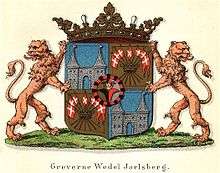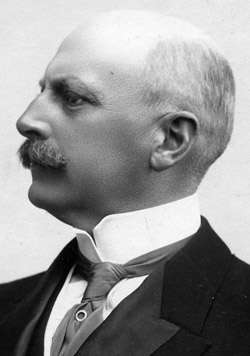Counts of Wedel-Jarlsberg


The Count of Wedel-Jarlsberg (also Wedel Jarlsberg) is a title of the Norwegian nobility and of the Danish nobility. The family of Wedel-Jarlsberg is a branch of the family von Wedel, which comes from Pomerania, Germany. Family members have had a significant position in the 18th and 19th centuries' Norwegian history.[1]
Feudal Count Johan Caspar Herman Wedel-Jarlsberg played in 1814 an active role in the constitutional assembly at Eidsvoll, and was the first native Norwegian to hold the post of Governor-general of Norway (representing the absent king as head of the Norwegian cabinet) during the union with Sweden.[2]
Barons of Wedel-Jarlsberg
Several members of the Wedel-Jarlsberg family, and mainly younger sons and daughters of the count, had baronial dignity.[3]
1821
The 1821 Law of Nobility abolished noble privileges and the recognition of noble titles in Norway, but, however, allowed the current bearers to keep the recognised noble status and titles for their lifetime. Thus, the title Feudal Count of Wedel-Jarlsberg did not end until the death of Feudal Count Peder Anker Wedel-Jarlsberg (1809–1893). [4]
Jarlsberg Hovedgård
Jarlsberg Manor and Estate (Jarlsberg Hovedgård) three kilometres northwest of the centre of the town of Tønsberg in Vestfold, Norway has traditionally been the residence of members of the Wedel-Jarlsberg family. In September 1683, Ulrik Fredrik Gyldenløve, the illegitimate son of the King, sold the manor to Danish officer Gustav Wilhelm Wedel Jarlsberg (1641-1717) who was made Commanding General in Norway in 1681. Field Marshal von Wedel received the name Wedel af Jarlsberg in 1684, at which time he by letters patent was created a feudal count.[5][6]
After a fire in 1699, the manor house was built up again. In 1812, Feudal Count Johan Caspar Herman Wedel-Jarlsberg rebuilt the manor in the empire style. Around the manor house there were arranged big, but simple garden and parks areas.[7]
The manor house is mainly from 1812, but with various improvements. The first floor of the main building is the column hall that has been used for concerts. Knight's hall on the second floor is used for private companies. There are other public trails over the property along the shoreline and through woodland which is also a private cemetery. Jarlsberg Estate is today one of Norway's largest farm with about 750 acres (3.0 km2) cultivated land.[8]
Gallery
 Gustav Wilhelm Wedel Jarlsberg (1641-1717)[9]
Gustav Wilhelm Wedel Jarlsberg (1641-1717)[9] Count Johan Caspar Herman Wedel-Jarlsberg (1779-1840)[10]
Count Johan Caspar Herman Wedel-Jarlsberg (1779-1840)[10] Ferdinand Carl Maria Wedel Jarlsberg(1781-1857) [11]
Ferdinand Carl Maria Wedel Jarlsberg(1781-1857) [11] Baron Fredrik Hartvig Herman Wedel Jarlsberg (1855-1942) [12]
Baron Fredrik Hartvig Herman Wedel Jarlsberg (1855-1942) [12]
See also
References
- ↑ Jon Gunnar Arntzen. "Jarlsberg". Store norske leksikon. Retrieved July 1, 2017.
- ↑ Odd Arvid Storsveen "Herman Wedel Jarlsberg" Norsk biografisk leksikon
- ↑ Jon Gunnar Arntzen. "Wedel Jarlsberg". Store norske leksikon. Retrieved July 1, 2017.
- ↑ Jon Gunnar Arntzen "Wedel" Store norske leksikon
- ↑ "Jarlsberg hovedgård" (Grevskapet Jarlsberg)
- ↑ Øystein Rian. "Gustav Wilhelm Wedel Jarlsberg". Norsk biografisk leksikon. Retrieved July 1, 2017.
- ↑ "Historie". Jarlsberg Hovedgard. Retrieved July 1, 2017.
- ↑ "Jarlsberg Hovedgaard Sem og Slagen" (en bygdebok. 2. bind: Kulturhistorie - første del Tønsberg: Høgskolen i Vestfold, 2001)
- ↑ Carl Frederik Bricka. "Gustav Vilhelm, Greve til Jarlsberg, 1641–1717". Dansk biografisk Lexikon. Retrieved July 1, 2017.
- ↑ Knut Dørum. "Herman Wedel Jarlsberg". Store norske leksikon. Retrieved July 1, 2017.
- ↑ Roald Berg. "Ferdinand Carl Maria Wedel Jarlsberg". Norsk biografisk leksikon. Retrieved July 1, 2017.
- ↑ Knut Dørum. "Fredrik Hartvig Herman Wedel Jarlsberg". Store norske leksikon. Retrieved July 1, 2017.